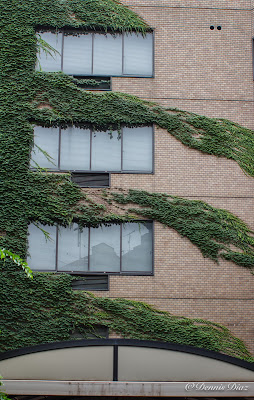July 6, 2014. My run started earlier than usual. I ventured out farther into the outskirts of Osaka. I felt my endurance building and my familiarity of the city giving me better confidence in navigating through places I haven’t been to. I got braver in getting lost and finding my way around the enormous urban landscape. I was prepared to step out my comfort zone and extend unknowing of what lay ahead. It was a personal philosophy I started long ago. Start easy, familiarize, and then go all out. I blistered through alleys, darker corridors, and hidden temples losing sight of waypoints that would take me back to where I started. For a while I was lost. Every street I turned to was new. The time I set to start running back passed and I was still running on new streets. I navigated on instinct using landmarks and the river to guide me back. I ran on even newer paths but the city guided me back in and I arrived at the hotel with time to spare.
A vast view of the
city accompanied my breakfast. As I
sipped my coffee slowly, I looked out onto the broad horizon of the concrete
jungle that almost swallowed me whole. I
felt a grin on my face. I took another
sip and let the grin stay on as I finished breakfast.
We headed for
Ibaraki of the Osaka Prefecture. We
visited the “Church of the Light,” the main chapel of the Ibaraki Kasugaoka
Church.[7] Unlike what we
have seen so far, “Church of the Light,” featured modernist architecture featuring an ultra minimalist approach. It had none of the
intricate wooden eaves, fancy sculptures, Buddhas, dragons, and towers.
We walked towards the church under gray skies drizzling us of light raindrops riding a gentle breeze patting our skins. The façade of the church, as we approached, did not inspire much like the temples of immense scale. It was drab of color, gray like the dark cloudy sky under which it stood. It was a plain concrete structure that nestled in a corner of a quaint neighborhood. The fact it was designed by renowned Japanese architect Tadao Ando, didn’t help much in giving it a special air of impressiveness. I walked with everyone into the church, looked closer at the angles of construction, and walked through the spaces in between walls. It was only then I began to appreciate the creativity, simplicity and the profound Zen-like meaning brought into the design composition of the church. I was again nudged off-balance by the drastic change in designs I witnessed, from grand intricate temples to simple effective minimalism.
My attention was captured by the interplay of the simple solid concrete construction and the light that permeated the structure; both heavy and light conversed in a pattern that rendered an observer confused whether he felt grounded solid or floated on nothing. The giant cross inscribed through and through on the east facing side of the church became an immediate focal point upon entering the main hall. The light cut the room and seized anyone who entered and, as I have experienced first-hand, almost felt as though the light grabbed at me from the opposite end of the hall. I stood where the contrast of light and dark was heaviest and it was there the effects could be felt drastic. The way the light touched my skin from the dark corner from which I stood felt surreal, symbolic and profound.
Each sat down on the dark wooden benches facing the east, facing the cross, and facing the light. After a few minutes of staring through the infinity of the open nothingness of the cross’ natural light, I felt serenity, security, and peace. I’m not a devout practicing Catholic but if I felt as such I could imagine a magnified effect on others of even stronger faith. I whispered a silent prayer and thought reverently; travelling all the way to Japan for that one experience, to be touched by the light, was without doubt worth it.




































































No comments:
Post a Comment